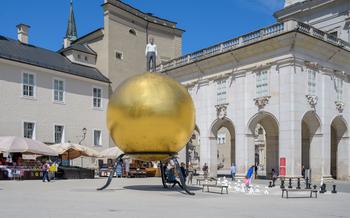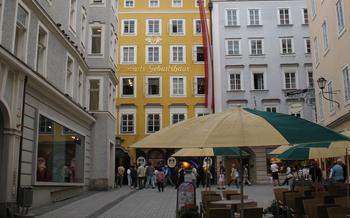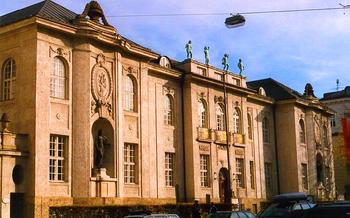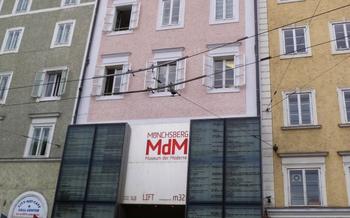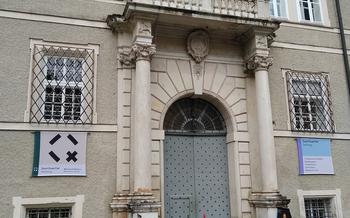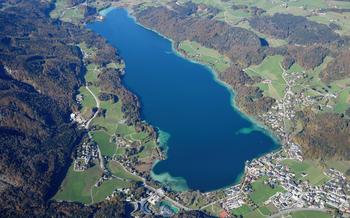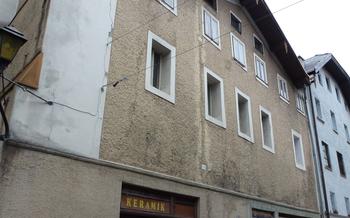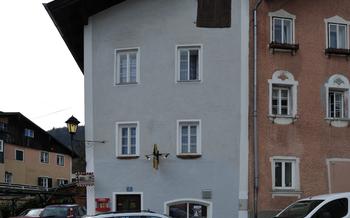
Salzburg Witch Trials Memorial
- The Memorial's Design: A Place for Reflection
- Memorial's Impact on Salzburg's History
- Personal Stories and Testimonies
- Guided Tours and Educational Programs
- Practical Information for Visitors
- Location in the Heart of Salzburg's History
- Integration of Art and History
- Symbol of Resilience and Hope
- International Significance: Lessons from the Past
- Local Initiatives for Reconciliation
- Research and Documentation Center
- Annual Commemoration Events
- Insider Tip: Hidden Gems
The Memorial's Design: A Place for Reflection
The Salzburg Witch Trials Memorial is a powerful and evocative work of art that serves as a place for reflection and contemplation. Designed by the renowned Austrian artist, Alfredo Barsuglia, the memorial features a central sculpture that depicts a group of seven women standing in a circle. These figures, cast in bronze, are a poignant reminder of the many women who were accused and executed during the witch trials.
Water plays a significant role in the memorial's design, with a series of cascading fountains that surround the central sculpture. The sound of the water creates a tranquil and meditative atmosphere, inviting visitors to pause and reflect on the suffering endured by the victims of the witch hunts.
The use of light in the memorial is equally symbolic. At night, the memorial is illuminated by a soft, ethereal glow that casts a warm and welcoming light on the surroundings. This lighting not only enhances the visual impact of the memorial but also creates a sense of serenity and peace, encouraging visitors to reflect on the human cost of the witch trials.
Memorial's Impact on Salzburg's History
The Salzburg Witch Trials Memorial has had a profound impact on shaping local attitudes towards the witch trials and promoting reconciliation and remembrance. The memorial serves as a stark reminder of the dark chapter in Salzburg's history, challenging the city to confront its past and acknowledge the suffering inflicted upon those accused of witchcraft.
The memorial's powerful design and poignant narratives have sparked important conversations about the witch hunts and their legacy. Through educational programs and guided tours, the memorial actively engages visitors in understanding the historical context and human stories behind the trials.
The memorial has become a catalyst for reconciliation and healing, fostering a sense of empathy and compassion for the victims. Local initiatives and grassroots efforts have emerged to promote awareness and remembrance, organizing community events, exhibitions, and educational workshops. These initiatives have helped to create a more inclusive and understanding atmosphere in Salzburg, acknowledging the injustice and suffering of the past.
The memorial's presence has also encouraged further research and documentation of the witch trials. Scholars and historians have delved deeper into the archives, uncovering new insights and shedding light on the complexities of this dark period. The memorial has become a valuable resource for researchers, providing access to historical documents and fostering collaboration between experts.
Personal Stories and Testimonies
The Salzburg Witch Trials Memorial is not just a historical site; it is also a place of profound emotional significance for the descendants of those who were accused of witchcraft. For them, the memorial is a tangible connection to their ancestors, a place where they can come to remember and grieve.
One such descendant is Maria, whose great-great-grandmother was executed as a witch in 167Maria grew up hearing stories about her ancestor's tragic fate, and she always felt a deep connection to her. When she first visited the memorial, she was overwhelmed with emotion.
"It was like finally finding a place where my great-great-grandmother's memory was honored," she says. "I could feel her presence there, and it was incredibly moving."
Maria's story is just one of many. The memorial has become a place of healing and reconciliation for countless descendants of those who were accused of witchcraft. It is a place where they can come to learn about their family history, to grieve their losses, and to find a sense of peace.
For visitors to the memorial, hearing the personal stories of survivors is a powerful reminder of the human cost of the witch trials. These stories help to bring the past to life and to make the memorial a truly immersive experience.
Guided Tours and Educational Programs
The Salzburg Witch Trials Memorial offers guided tours in multiple languages, allowing visitors to explore the memorial and learn about its significance in depth. These tours provide a comprehensive overview of the witch trials, shedding light on the historical context, the stories of the accused, and the impact of the trials on Salzburg's history.
For groups and schools, the memorial offers educational programs that delve deeper into the complexities of the witch trials. These programs are designed to promote understanding and tolerance, encouraging participants to critically examine the factors that led to the persecution of innocent individuals. Through interactive activities, discussions, and workshops, students gain insights into the social, cultural, and political dynamics that fueled the witch hunts.
By participating in guided tours and educational programs, visitors can gain a profound understanding of the Salzburg Witch Trials Memorial and its role in promoting remembrance, reconciliation, and historical awareness.
Practical Information for Visitors
Opening hours and admission fees:
- The Salzburg Witch Trials Memorial is open to the public from Tuesday to Sunday, with varying hours depending on the season.
- Admission is free of charge, allowing visitors to explore the memorial at their own pace.
Contact details:
- For inquiries, visitors can contact the memorial's administration via email or phone.
- The memorial's official website provides comprehensive information, including contact details and updates on events and exhibitions.
Accessibility:
- The memorial is fully accessible to visitors with disabilities, featuring ramps, elevators, and accessible restrooms.
- Guided tours and educational programs can be adapted to accommodate the needs of visitors with disabilities.
Suggested duration of visit and recommended time of day:
- Allow at least one hour to fully explore the memorial's exhibits and immerse yourself in the history of the witch trials.
- Consider visiting during the late afternoon or evening when the memorial's atmosphere is particularly evocative, with the play of light and water creating a serene and contemplative ambiance.
Location in the Heart of Salzburg's History
The Salzburg Witch Trials Memorial is situated in the heart of Salzburg's historic district, a short walk from many of the city's most iconic landmarks. This central location allows visitors to easily integrate a visit to the memorial into their exploration of Salzburg's rich history.
The memorial is just a few steps away from the Getreidegasse, one of Salzburg's most famous shopping streets. The street is lined with historic buildings, boutiques, and cafes, offering visitors a chance to soak up the city's vibrant atmosphere.
From the memorial, it's also a short walk to the Salzburg Cathedral, one of the city's most recognizable landmarks. The cathedral's imposing Baroque architecture and its connection to Salzburg's religious history make it a must-see for any visitor.
For those interested in delving deeper into Salzburg's past, the memorial is also close to several other museums and historical sites. The Salzburg Museum, located just across the river, offers a comprehensive overview of the city's history, from its Celtic roots to the present day. The Mozart Museum, dedicated to the life and work of Salzburg's most famous son, is also within easy walking distance.
By visiting the Salzburg Witch Trials Memorial, travelers can gain a deeper understanding of the city's complex history while also appreciating its architectural and cultural heritage. The memorial's central location makes it an ideal starting point for a broader exploration of Salzburg's many treasures.
Integration of Art and History
The Salzburg Witch Trials Memorial collaborates with contemporary artists to create thought-provoking exhibitions and installations that explore the themes of witchcraft, persecution, and the human condition. These artworks challenge traditional narratives and encourage visitors to engage with the memorial's message in new and unexpected ways.
Exhibitions have featured works by local, national, and international artists, using various media such as painting, sculpture, photography, and mixed media. The memorial's unique setting provides a powerful backdrop for artistic expression, allowing visitors to experience the history of the witch trials through a contemporary lens.
By integrating art with history, the memorial aims to foster dialogue and reflection on the complex issues surrounding the witch trials. Artworks provoke thought, challenge perspectives, and offer alternative interpretations of the past. They invite visitors to consider the broader implications of the witch hunts and their relevance to contemporary society.
Through this integration of art and history, the Salzburg Witch Trials Memorial becomes a dynamic and engaging space for learning, remembrance, and contemplation, encouraging visitors to explore the past and its connections to the present.
Symbol of Resilience and Hope
The Salzburg Witch Trials Memorial stands as a testament to the indomitable spirit of those who endured unimaginable suffering and persecution. It serves as a poignant reminder of the strength of the human spirit in the face of adversity and the importance of standing up against injustice and intolerance. The memorial honors the victims of the witch trials, recognizing their resilience and perseverance in the face of overwhelming odds. It is a place of profound reflection and contemplation, inviting visitors to consider the power of hope and resilience in overcoming darkness and oppression. The memorial's existence is a powerful symbol of the triumph of the human spirit over adversity, reminding us that even in the darkest of times, the light of hope can prevail.
International Significance: Lessons from the Past
The Salzburg Witch Trials Memorial holds immense international significance, transcending the boundaries of the city and resonating with a global audience. It serves as a poignant reminder of the dark chapters in human history, when superstition, fear, and intolerance led to the persecution and execution of innocent individuals.
The memorial contributes to a broader understanding of the history of witch trials, a phenomenon that extended beyond Salzburg and affected countless lives across Europe and beyond. By shedding light on this tragic past, the memorial serves as a catalyst for critical reflection and dialogue on the dangers of prejudice, discrimination, and the abuse of power.
Moreover, the memorial's existence is a powerful symbol of resilience and hope. It stands as a testament to the indomitable spirit of those who were unjustly accused and persecuted, and it encourages us to stand up against injustice and intolerance in all its forms. The memorial's message of reconciliation and remembrance reverberates across borders, inspiring individuals and communities worldwide to confront their own histories of persecution and to work towards a more just and equitable future.
Local Initiatives for Reconciliation
Beyond the memorial itself, the local community has played a vital role in promoting healing and reconciliation related to the Salzburg witch trials. Grassroots initiatives, driven by passionate individuals and organizations, have emerged to raise awareness, foster dialogue, and create a sense of collective responsibility.
One notable initiative is the annual "Witch Trials Commemoration Walk," which brings together residents, descendants of those accused, and visitors to retrace the steps of the victims. During the walk, participants read aloud the names of those who were executed, creating a powerful and moving tribute.
Local theater groups have also contributed by staging plays and performances that explore the themes of the witch trials and their impact on the community. These productions provide a platform for dialogue and reflection, allowing audiences to connect with the stories of those who suffered.
Furthermore, local historians and researchers have dedicated themselves to uncovering and documenting the stories of the accused. Their tireless efforts have shed light on the lives and experiences of these individuals, helping to humanize the victims and challenge the misconceptions that fueled the trials.
Research and Documentation Center
The Salzburg Witch Trials Memorial is not just a place of remembrance; it also serves as a center for research and documentation. The memorial houses a comprehensive archive of historical documents, manuscripts, and artifacts related to the witch trials in Salzburg. These materials are available to scholars, researchers, and the general public, providing a valuable resource for studying this dark chapter in history.
The memorial collaborates with universities, research institutions, and individual scholars to conduct ongoing research projects on the witch trials. These projects aim to uncover new information, shed light on lesser-known aspects of the trials, and contribute to a deeper understanding of the historical context and social dynamics that led to the persecution of innocent people.
The research and documentation center at the memorial plays a crucial role in preserving the memory of the witch trials and ensuring that the lessons learned from this tragic period in history are not forgotten. By providing access to historical materials and facilitating scholarly research, the memorial contributes to the broader understanding of the witch trials and their impact on society.
Annual Commemoration Events
The Salzburg Witch Trials Memorial hosts regular events and ceremonies to honor the victims of the witch trials and to promote reconciliation and remembrance. These events are attended by local officials, historians, and community members, and they provide an opportunity for the community to come together and collectively mourn the tragic events of the past. The memorial's annual commemoration events are an important part of its mission to raise awareness about the witch trials and to ensure that the victims are never forgotten.
One of the most significant events is the annual memorial service, which is held on the anniversary of the burning of the last witch in Salzburg. During the service, the names of the victims are read aloud, and a wreath is laid in their memory. Other events include lectures, workshops, and exhibitions that explore the history of the witch trials and their impact on Salzburg and its people.
These events are not only a way to remember the victims of the witch trials but also to promote reconciliation and healing within the community. By acknowledging the past and working together to create a more just and tolerant society, the people of Salzburg can help to ensure that such atrocities never happen again.
Insider Tip: Hidden Gems
Beyond the main exhibits and narratives, the Salzburg Witch Trials Memorial holds hidden gems that offer unique perspectives on the dark chapter of history it represents. Explore the memorial's archives to uncover lesser-known stories of individuals accused of witchcraft. These forgotten tales provide a glimpse into the lives of those who suffered during the trials. Look out for special events and exhibitions that delve deeper into specific aspects of the witch hunts, showcasing rare artifacts and documents. Take the time to wander around the memorial's serene gardens, where sculptures and installations offer subtle references to the trials, inviting you to contemplate the memorial's message in a tranquil setting. Whether it's through these hidden gems or the powerful narratives that form the core of the memorial, visitors will find a wealth of insights waiting to be discovered.
